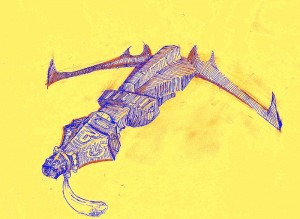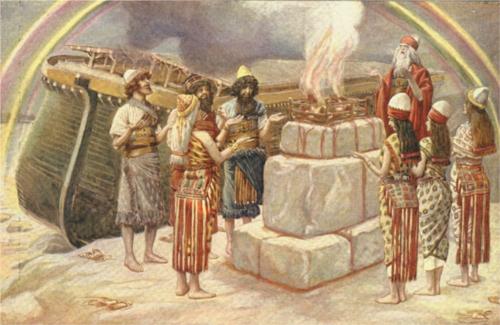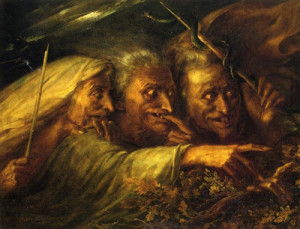
Lucicrucilest (illustration by Gus L.)
Fragment of a dispatch from the Sage Strodastin of Zorfath to High Merchant Thracle.
Also know as chiastons by western mercenaries, crucilests are seemingly magical weapons used by the invaders known as tangles†. The weapon name comes from a heavy crossbar which always occurs near the business end of the weapon, giving an appearance something like a crossbow without string or lever. Speculation: the similarity between the symbol of the Old Empire and this weapon can’t possibly be a coincidence. In some instances, the crossbar curves forward, like horns.
Crucilests discovered so far include:
- Electrocrucilest: a stocked weapon of approximately the bulk of a heavy crossbow. So named because it seems to discharge a ray of lightning.
[Range as crossbow, to-hit as normal, 4d6 damage, save for half, may ignite flammables.] - Lucicrucilest: similar to the electrocrucilest in appearance, this weapon emits a beam of light as thick around as a clenched fist. The colors and strengths of lucicrucilest emissions seem to vary, and some devices have been seen with complicated crystal arrays at their tips. These crystals are of no mineral that I have so far encountered.
[Range as crossbow, auto-hit, save versus death ray or die.] - Cumulocrucilest: similar in size to the electrocrucilest, this device emits a wide fan of malefic discharge, melting and burning all in its path.
[Area of effect 45 degree fan, 60′ radius, Xd6 damage, save versus breath weapon for half.] - Tridoform Crucilest: a melee weapon, often with three prongs, used to deliver a powerful blast of corruption.
[Melee range, to-hit as normal, 1d6 damage and save versus death ray or die.]
Forgive the impertinence, Lord, but I have named the devices myself for ease of reference. If you believe that other names might be more appropriate commercially, especially for sale in the north, please let me know your preferences at your earliest convenience.
The ammunition used by these weapons is unknown, and the tinkers we have hired to examine (and disassemble, in one case, with disastrous consequences) have not been able to make heads or tails of their workings. Crystals embedded in the device seem to reflect the shots remaining.
My Lord will be pleased to note that the few examples of these foreign artifacts that have come into stock at the Zorfath branch of the Grand Emporium have generated princely profits.
† The etymology of this word is unclear, but I have reason to believe that it originated with the soldiers of fortune known as The Company of Gavin, previously based here in Zorfath, but now in unknown locations. One of my apprentices, however, believes the term is derogatory, and derived from mercenaries operating in the service of Efulziton Necromanticus in the west.
Note to Pahvelorn players: the tangle weapons you have found so far are a lucicrucilest and tridoform crucilest (these were the first found early on in the Vaults) and a 4d6 cumulocrucilest (which devastated the party in the northwestern cliff barrows).









